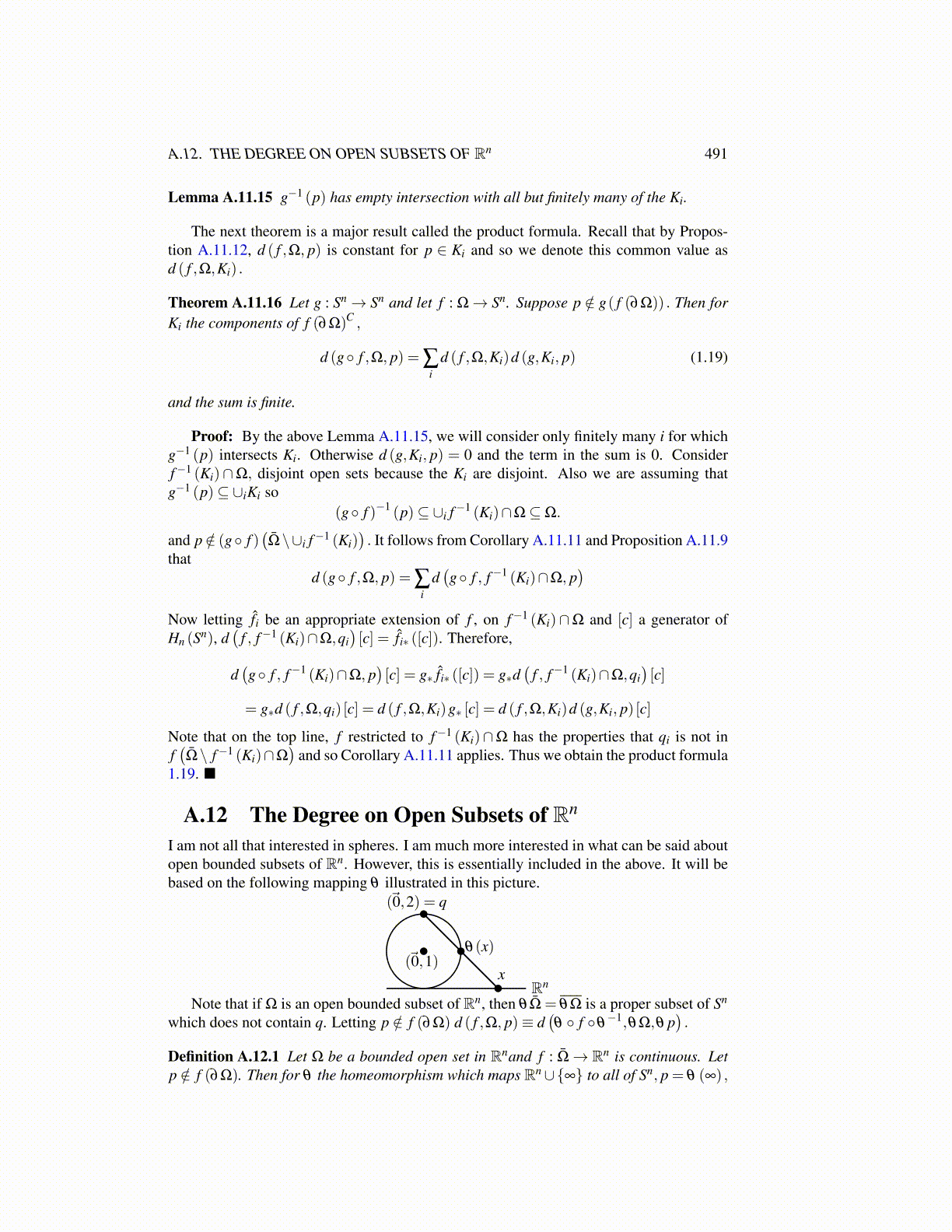
A.12. THE DEGREE ON OPEN SUBSETS OF Rn 491
Lemma A.11.15 g−1 (p) has empty intersection with all but finitely many of the Ki.
The next theorem is a major result called the product formula. Recall that by Propos-tion A.11.12, d ( f ,Ω, p) is constant for p ∈ Ki and so we denote this common value asd ( f ,Ω,Ki) .
Theorem A.11.16 Let g : Sn→ Sn and let f : Ω→ Sn. Suppose p /∈ g( f (∂Ω)) . Then forKi the components of f (∂Ω)C ,
d (g◦ f ,Ω, p) = ∑i
d ( f ,Ω,Ki)d (g,Ki, p) (1.19)
and the sum is finite.
Proof: By the above Lemma A.11.15, we will consider only finitely many i for whichg−1 (p) intersects Ki. Otherwise d (g,Ki, p) = 0 and the term in the sum is 0. Considerf−1 (Ki)∩Ω, disjoint open sets because the Ki are disjoint. Also we are assuming thatg−1 (p)⊆ ∪iKi so
(g◦ f )−1 (p)⊆ ∪i f−1 (Ki)∩Ω⊆Ω.
and p /∈ (g◦ f )(Ω̄\∪i f−1 (Ki)
). It follows from Corollary A.11.11 and Proposition A.11.9
thatd (g◦ f ,Ω, p) = ∑
id(g◦ f , f−1 (Ki)∩Ω, p
)Now letting f̂i be an appropriate extension of f , on f−1 (Ki)∩Ω and [c] a generator ofHn (Sn), d
(f , f−1 (Ki)∩Ω,qi
)[c] = f̂i∗ ([c]). Therefore,
d(g◦ f , f−1 (Ki)∩Ω, p
)[c] = g∗ f̂i∗ ([c]) = g∗d
(f , f−1 (Ki)∩Ω,qi
)[c]
= g∗d ( f ,Ω,qi) [c] = d ( f ,Ω,Ki)g∗ [c] = d ( f ,Ω,Ki)d (g,Ki, p) [c]
Note that on the top line, f restricted to f−1 (Ki)∩Ω has the properties that qi is not inf(Ω̄\ f−1 (Ki)∩Ω
)and so Corollary A.11.11 applies. Thus we obtain the product formula
1.19. ■
A.12 The Degree on Open Subsets of Rn
I am not all that interested in spheres. I am much more interested in what can be said aboutopen bounded subsets of Rn. However, this is essentially included in the above. It will bebased on the following mapping θ illustrated in this picture.
(⃗0,2) = q
(⃗0,1)x
θ(x)
Rn
Note that if Ω is an open bounded subset of Rn, then θΩ̄ = θΩ is a proper subset of Sn
which does not contain q. Letting p /∈ f (∂Ω) d ( f ,Ω, p)≡ d(θ ◦ f ◦θ
−1,θΩ,θ p).
Definition A.12.1 Let Ω be a bounded open set in Rnand f : Ω̄→ Rn is continuous. Letp /∈ f (∂Ω). Then for θ the homeomorphism which maps Rn∪{∞} to all of Sn, p = θ (∞) ,